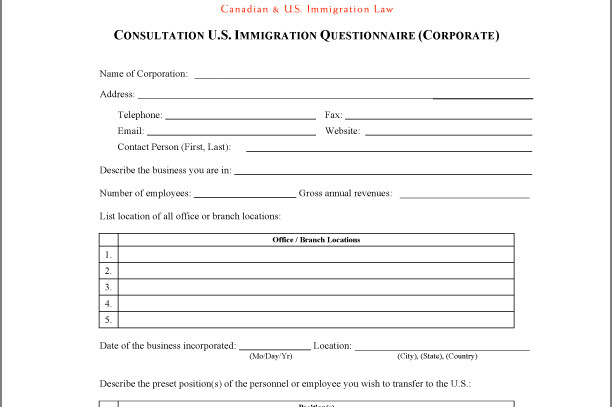E-2 Treaty Investor Visa Overview
E-2 Visas are nonimmigrant visas that are sometime called the next best thing to “green cards” i.e. permanent resident status.
In Canada, E-2 Visas are processed through U.S. Consulates located in Vancouver and Toronto (with limited processing in Calgary). This visa is issued for a period of one to five years and can be renewed indefinitely so long as the underlying fact pattern continues to support the requirements for the E-2 Visa.
Clients often ask if there is a minimum amount of investment required. The correct answer is “No” – there is no “bright line” test that is applied by any of the three governmental agencies involved: Department of State, USCIS, USCBP. Many years ago, when NAFTA was young, we successfully presented a case involving an investment of $20,000. This case was approved because we were able to convincingly demonstrate that only $20,000 was needed to start up that business.
Times change. There is still no official bright line but decades of experience has given me a de facto bright line: if my client can invest at least $100,000 and if the application is well documented, it will most likely be approved.
REQUIREMENTS:
(1) A Treaty of Friendship, Commerce and Navigation or Bilateral Investment Treaty between the U.S. and the country of which the company and the applicant is a national.
NAFTA covers Canadian and Mexican citizens. Canadian Permanent Residents are not eligible for NAFTA benefits.
(2) The individual and/or business possess the nationality of the treaty country.
For Canadian citizens, a copy of the passport, birth certificate, or citizen card is sufficient proof. For qualified citizens of other signatory countries, the equivalent document from their country of nationality will suffice.
(3) Applicant has invested, or is actively in the process of investing within the meaning of INA 101(a)(15)(E).
Key factors in determining whether the applicant has appropriately invested, or is in the process of investing are:
• Possession and control of the assets invested. The applicant needs to show that the assets or funds invested are in his/her name and they have control over them. (Note: An inherited business is not an investment. But an inheritance used to purchase or start a business would be considered an “investment”.).
• The investment must be “at-risk”. To be “at-risk” the investment funds must be subject to loss if the business fails. Indebtedness secured by the assets of the business is not considered “at-risk” – thus purchasing an investment property with minimal down payment and entering into a substantial mortgage agreement may not qualify. “At-risk” funds include only funds in which personal assets are involved.
PLEASE CALL US at 425-259-1807 or email terrypreshaw@myborderlawyer.com for an E-2 INVESTMENT EVALUATION ($425) BEFORE YOU BUY OR INVEST!
• Funds must be irrevocably committed. Examples of irrevocably committed funds are funds held in escrow pending issuance of the visa and funds already paid for the purchase of the business. Examples of funds that are not irrevocably committed are uncommitted funds in a bank account and prospective investment arrangements involving no present commitment. To satisfy this requirement the applicant must provide documents that indicate that the applicant has already committed these funds to the business and that these funds are under his/her control.
• The investor must document the source of these funds (i.e. loan, sale of assets, bank account, etc.).
(4) Enterprise is a real and operating commercial enterprise.
Speculative investments held for potential appreciation in value do not qualify. Non-profit organizations also do not qualify.
(5) Applicant’s investment is substantial.
The determination whether an investment is substantial consists of the following:
• Applying the proportionality test – The proportionality test is a comparison of the total cost (the purchase price of an existing business or the cost of making a newly created business operational) of the enterprise and the amount of qualifying funds invested. The lower the cost of the business, the higher the percentage of qualifying funds invested needed to qualify. Determining whether the funds are sufficient to ensure the investor’s commitment to the successful operation of the enterprise and to its development and direction.
(6) The Investment is more than a marginal one solely for earning a living.
The applicant can show that an investment is more than marginal in one of two ways.
• First, submit documents showing that the income derived from the investment exceeds what is necessary to support the applicant and family. Income tax forms from the business and/or income statements prepared by an accountant are a means of providing credible documentation;
• Failing this test, the applicant can show that the investment has the capacity, present or future, to make a significant economic contribution to the community. In this regard, submit documents that demonstrate, through credible evidence, the number of workers the business will employ, now and in the future.
(7) Applicant is coming to the U.S. to “develop and direct” the enterprise.
(8) The applicant, if an employee, will be engaged in an executive/ supervisory position or possesses skills essential to the firm’s operations in the U.S.
An executive or supervisory position is one, which entails a high degree of responsibility for the firm’s overall operations, and the executive or supervisory element is the primary function of the job.
An essential employee is one without which the applicant would not be able to do business in the U.S. The burden of proof falls upon the applicant to prove that the prospective employee is essential.
To bring an employee into the U.S., the applicant must meet the following criteria:
• The prospective employer must meet the nationality requirements as described in number 2 above;
• The employer and employee must have the same nationality; and
•The employer, if not resident abroad, must be maintaining E status in the U.S.
(9) The applicant intends to depart the United States when the E status is relinquished or terminates.

